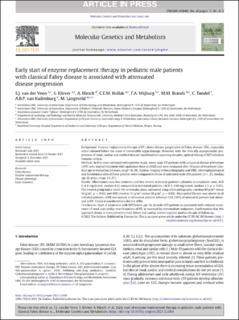| dc.contributor.author | van der Veen, Sanne | |
| dc.contributor.author | Körver, Simon | |
| dc.contributor.author | Hirsch, A | |
| dc.contributor.author | Hollak, Carla E.M. | |
| dc.contributor.author | Wijburg, Frits A | |
| dc.contributor.author | Brands, M | |
| dc.contributor.author | Tøndel, Camilla | |
| dc.contributor.author | Van Kuilenburg, André B.P. | |
| dc.contributor.author | Langeveld, Miriam | |
| dc.date.accessioned | 2022-02-18T10:10:23Z | |
| dc.date.available | 2022-02-18T10:10:23Z | |
| dc.date.created | 2021-12-20T16:37:50Z | |
| dc.date.issued | 2022 | |
| dc.identifier.issn | 1096-7192 | |
| dc.identifier.uri | https://hdl.handle.net/11250/2979972 | |
| dc.description.abstract | Background
Enzyme replacement therapy (ERT) slows disease progression of Fabry disease (FD), especially when initiated before the onset of irreversible organ damage. However, with the clinically asymptomatic progression of renal, cardiac and cerebral disease manifestations spanning decades, optimal timing of ERT initiation remains unclear.
Methods
In this cross-sectional retrospective study, seven male FD patients with a classical disease phenotype (cFD) who started treatment with agalsidase-beta in childhood were evaluated after 10 years of treatment (median age at evaluation 24 years, range 14–26). Cardiac imaging (echocardiography and MRI), electrophysiological and biochemical data of these patients were compared to those of untreated male cFD patients (n = 23, median age 22 years, range 13–27).
Results
Albuminuria was less common and less severe in treated patients (albumin to creatinine ratio, ACR 0–8.8 mg/mmol, median 0.4) compared to untreated patients (ACR 0–248 mg/mmol, median 3.7, p = 0.02). The treated group had a lower left ventricular mass, measured using echocardiography (median 80 g/m2 versus 94 g/m2, p = 0.02) and MRI (median 53 g/m2 versus 68 g/m2, p = 0.02). Myocardial fibrosis was absent in all included patients. eGFR was normal in all treated patients whereas 7/23 (30%) of untreated patients had abnormal eGFR. Cerebral manifestations did not differ.
Conclusions
Start of treatment with ERT before age 16, in male cFD patients is associated with reduced occurrence of renal and cardiac manifestations of FD, as assessed by intermediate endpoints. Confirmation that this approach delays or even prevents renal failure and cardiac events requires another decade of follow-up. | en_US |
| dc.language.iso | eng | en_US |
| dc.publisher | Elsevier | en_US |
| dc.rights | Attribution-NonCommercial-NoDerivatives 4.0 Internasjonal | * |
| dc.rights.uri | http://creativecommons.org/licenses/by-nc-nd/4.0/deed.no | * |
| dc.title | Early start of enzyme replacement therapy in pediatric male patients with classical Fabry disease is associated with attenuated disease progression | en_US |
| dc.type | Journal article | en_US |
| dc.type | Peer reviewed | en_US |
| dc.description.version | publishedVersion | en_US |
| dc.rights.holder | Copyright 2021 The Authors | en_US |
| cristin.ispublished | true | |
| cristin.fulltext | original | |
| cristin.qualitycode | 1 | |
| dc.identifier.doi | 10.1016/j.ymgme.2021.12.004 | |
| dc.identifier.cristin | 1970681 | |
| dc.source.journal | Molecular Genetics and Metabolism | en_US |
| dc.source.pagenumber | 163-169 | en_US |
| dc.identifier.citation | Molecular Genetics and Metabolism. 2022, 135 (2), 163-169. | en_US |
| dc.source.volume | 135 | en_US |
| dc.source.issue | 2 | en_US |

